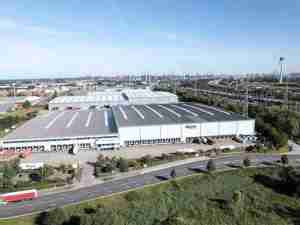Governor Larry Hogan today announced, in conjunction with the Maryland Department of Transportation Maryland Port Administration (MDOT MPA) and Federal Railroad Administration, that the planned Howard Street Tunnel expansion project in Baltimore has received a Finding of No Significant Impact (FONSI) as part of the project review under the National Environmental Policy Act (NEPA). Receipt of the FONSI follows the public review and comment period for the project’s environmental assessment conducted in March and April and represents final NEPA approval for the tunnel project.
“The Howard Street Tunnel expansion is a major infrastructure project that will significantly increase business for the Port of Baltimore,” said Governor Hogan. “This project will have a tremendous impact on Maryland’s economy, improve the flow of goods, and generate thousands of jobs in the Baltimore region.”
The project will expand the 126-year-old Howard Street Tunnel to accommodate double-stacked container trains traveling to and from the Helen Delich Bentley Port of Baltimore, increasing efficiency and capacity. NEPA approval allows CSX, which owns the tunnel, to finalize engineering and obtain permits. Construction will occur in phases and is expected to begin later this year.
“The final NEPA approval for the Howard Street Tunnel project is great news for the Port of Baltimore,” said MDOT MPA Executive Director William P. Doyle. “The reconstructed tunnel will grow our container business, opening up incredible business opportunities into the Midwest. It also will help reduce fuel consumption by 137 million gallons via this rail throughput. A Howard Street Tunnel that’s able to handle double-stack trains will grow jobs at the Port and get the Port over its longtime hurdle, the lack of double-stack rail.”
The project will make vertical clearance improvements at the Howard Street Tunnel and 22 other locations between Baltimore and Philadelphia. Three additional bridges in Baltimore City require superstructure work: the North Avenue bridge will be modified and the Guilford Avenue and Harford Road bridges will be fully replaced. Other locations in Maryland, Delaware, and Pennsylvania only require track lowering work beneath the structures.
For years, the Howard Street Tunnel reconstruction was estimated to cost between $1 billion and $4 billion, with significant disruption to surrounding communities. By utilizing advances in construction technology, CSX and Maryland determined it is possible to provide the needed clearance for significantly less money and minimal community impact. The cost is now estimated at $466 million, including $202.5 million from Maryland, $125 million in a federal INFRA (Infrastructure For Rebuilding America) grant, $113 million from CSX, $22.5 million from Pennsylvania, and $3 million in federal highway formula funding.
“The Howard Street Tunnel Project is an example of partners working across public, private, and community sectors to achieve a goal that benefits all,” said Secretary Greg Slater of MDOT. “This project will connect seamless double-stack access from Maine to Florida, and position the Port of Baltimore as the premiere hub to transport cargo up and down the East Coast.”
With its supersized cranes and deep container berth, the Port of Baltimore is one of only a few East Coast ports that can accommodate some of the biggest ships in the world. Dredging was recently completed for a second, 50-foot-deep berth at the Seagirt Marine Terminal, which is managed under a public-private partnership between MDOT MPA and Ports America Chesapeake. Four additional Neo-Panamax cranes will arrive this summer and will be operational by the end of the year, giving the Port the ability to serve two supersized ships simultaneously.
Double stacking capability at the Howard Street Tunnel will help the Port accommodate the container growth that will come from this added capacity. Its tunnel project also will generate 6,550 construction jobs, while an additional 7,300 jobs would be created due to increased business. Double stacking also will provide a more cost-effective way to transport freight by rail compared to trucks, reducing congestion along the I-95 corridor and delivering environmental benefits with less emissions.
The Port of Baltimore generates about 15,300 direct jobs, with nearly 140,000 jobs overall linked to Port activities. The Port ranks first among the nation’s ports for volume of autos and light trucks, roll on/roll off heavy farm and construction machinery, and imported gypsum. It ranks 11th among major U.S. ports for foreign cargo handled and 10th for total foreign cargo value.
“This is a great step forward to seeing the first double stack CSX train move through the Howard Street Tunnel,” said Brian Hammock, director of state relations for CSX. “This is another example of how we are working collaboratively with our port, state, and federal partners to modernize our rail infrastructure to bring consumer goods they use every day in a more efficient and sustainable manner.”
The environmental assessment period for the Howard Street Tunnel Project ran from March 1 through April 13. The FONSI document includes responses to comments from the environmental assessment, a summary of stakeholder outreach conducted during the comment period, selection of the conventional construction method for the tunnel clearance work, and other project details and updates.







